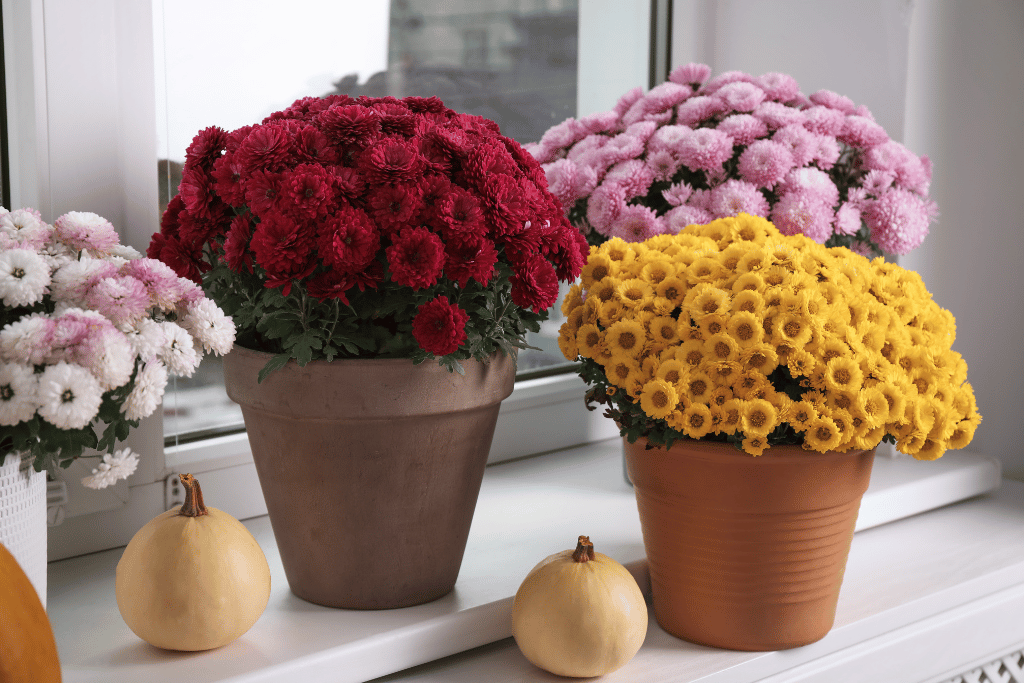Creating a welcoming atmosphere for special occasions is important to me, and I often use flowers as a centerpiece. Call it a fetish or something else, instead of a “color theme”, I go with the “letter theme”. And, this time – the letter theme was “T”. So, I had to get flowers that start with T.
I confess – it was super struggling to find flowers that start with the letter T, that also complemented the theme of the event.
To address this challenge, I collaborated with event planners and explored floral catalogs to discover options like the Tulip, with its elegant simplicity, and the showy Tansy, which adds a touch of vibrancy. These solutions have allowed me to effortlessly incorporate flowers starting with the letter T into my event décor, setting the perfect ambiance.
In addition to collaborating with event planners and exploring floral catalogs, I also experimented with creative ways to showcase T-flowers.
I’ve discovered that arranging Tulips alongside baby’s breath creates a delicate and charming effect, while combining Tansy with other bold-colored blooms adds a dynamic burst of color to the arrangement.
Moreover, I’ve found that educating myself about lesser-known T-flowers like Tulip and Trillium has expanded my options further, allowing me to craft unique and captivating displays.
So, without much ado, here are the flowers that start with T:
30 Flowers That Start With T
1. Tulip – Iconic Spring Blooms
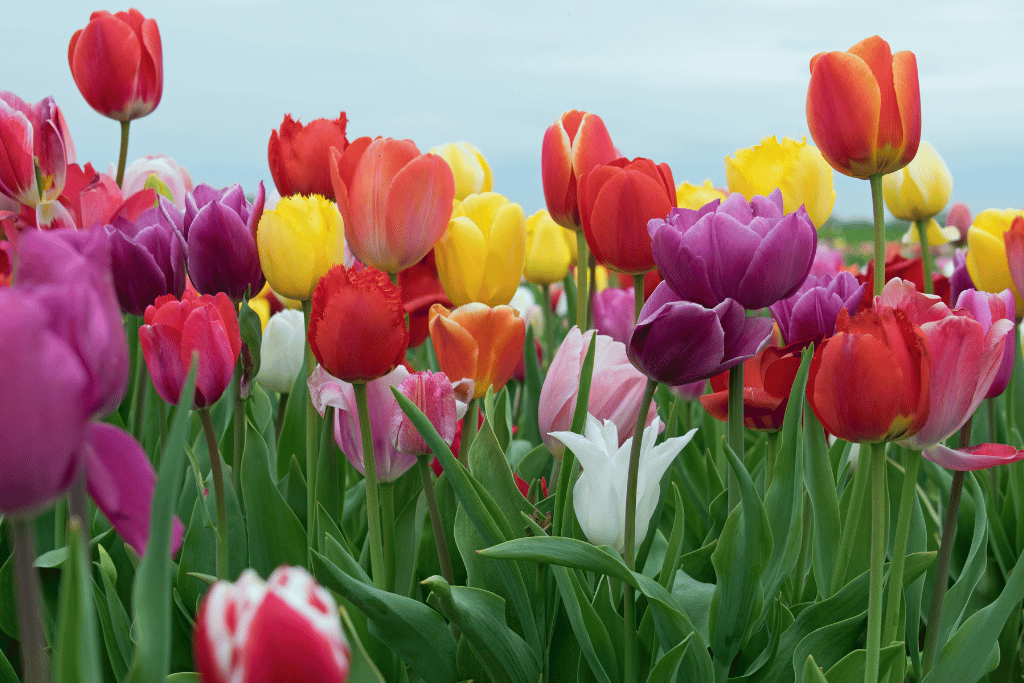
Tulips are undoubtedly one of the most iconic and beloved spring-blooming flowers. Their distinctive cup-shaped blossoms and a stunning array of colors make them a symbol of beauty and elegance. Belonging to the genus Tulipa, tulips offer a vast palette of shades, ranging from fiery reds and vibrant yellows to soft pastels. These flowers have a rich cultural history, often associated with perfect love and passion.
With their ability to transform landscapes into vibrant tapestries, tulips are a favorite choice for gardens, parks, and even indoor arrangements. Their symmetrical petals and graceful form create a sense of harmony and balance. Originating from Central Asia, tulips have gained global popularity, becoming a timeless representation of spring’s renewal and beauty.
2. Tiger Lily – Striking and Exotic
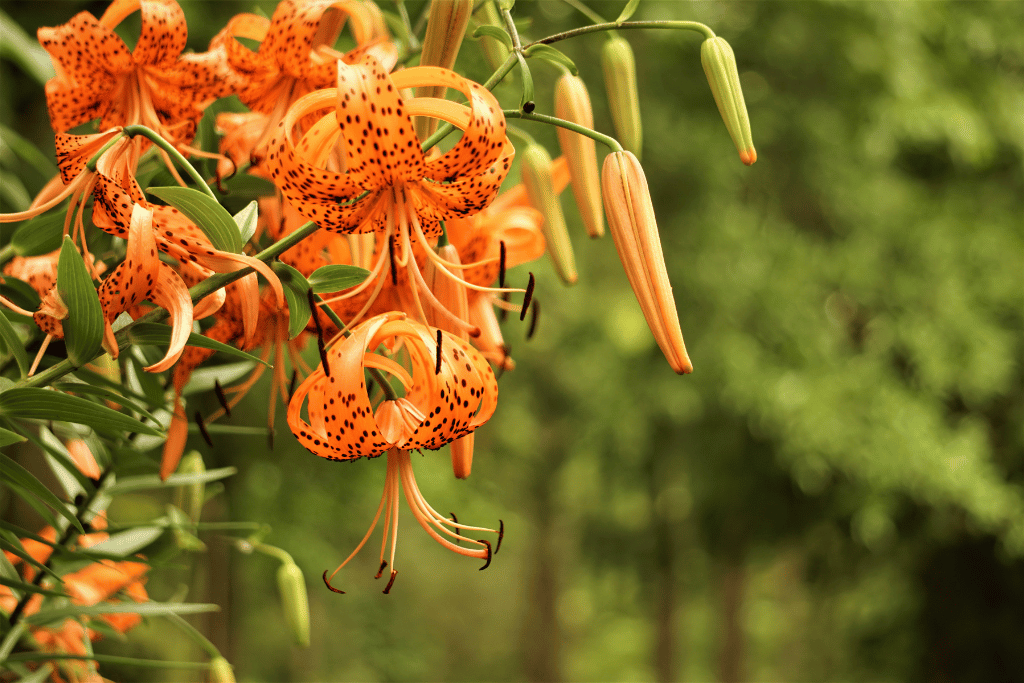
Tiger lilies, scientifically known as Lilium lancifolium, captivate with their striking appearance and exotic charm. These vibrant flowers feature large, trumpet-shaped blooms in a vivid orange hue, adorned with dark spots reminiscent of a tiger’s coat. Native to eastern Asia, tiger lilies stand out as a focal point in any garden or floral arrangement.
Tiger lilies are not only visually stunning but also carry cultural significance. They symbolize wealth, pride, and prosperity in various cultures. Their bold colors and unique patterns evoke a sense of admiration and awe, making them a sought-after addition to gardens aiming to create a dramatic visual impact. Whether planted en masse or as standalone specimens, tiger lilies bring a touch of the wild and untamed to any landscape.
3. Trillium – Delicate Woodland Beauties
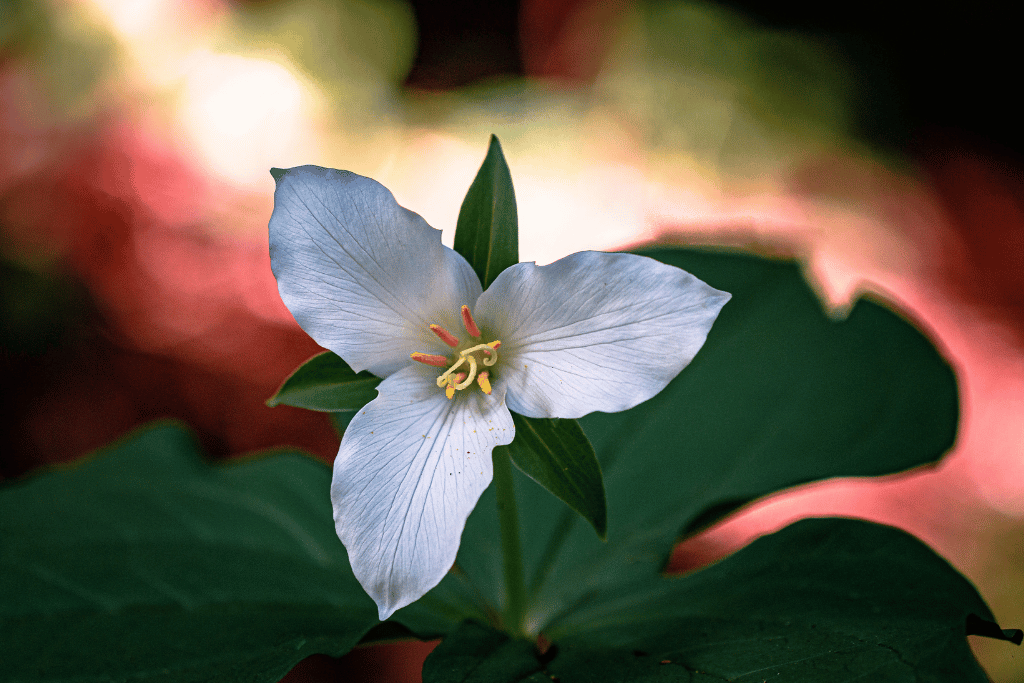
Native to North America, trilliums often grace the forest floor, adding an air of elegance to shaded woodlands. Trilliums, the delicate woodland flowers known for their understated beauty, thrive in shaded, moist environments, enchanting observers with their subtle charm. These perennial plants are characterized by their trio of graceful petals and three green sepals, creating a captivating threefold symmetry.
Due to their delicate nature and limited habitat, trilliums are a protected species in some areas, emphasizing the importance of their conservation. The white, pink, or red blooms of trilliums emerge in spring, attracting pollinators and signaling the awakening of the forest after winter’s slumber. Their unassuming presence and graceful demeanor remind us of nature’s intricate beauty and the importance of preserving fragile ecosystems.
4. Trumpet Vine – Attractive Climbing Blooms
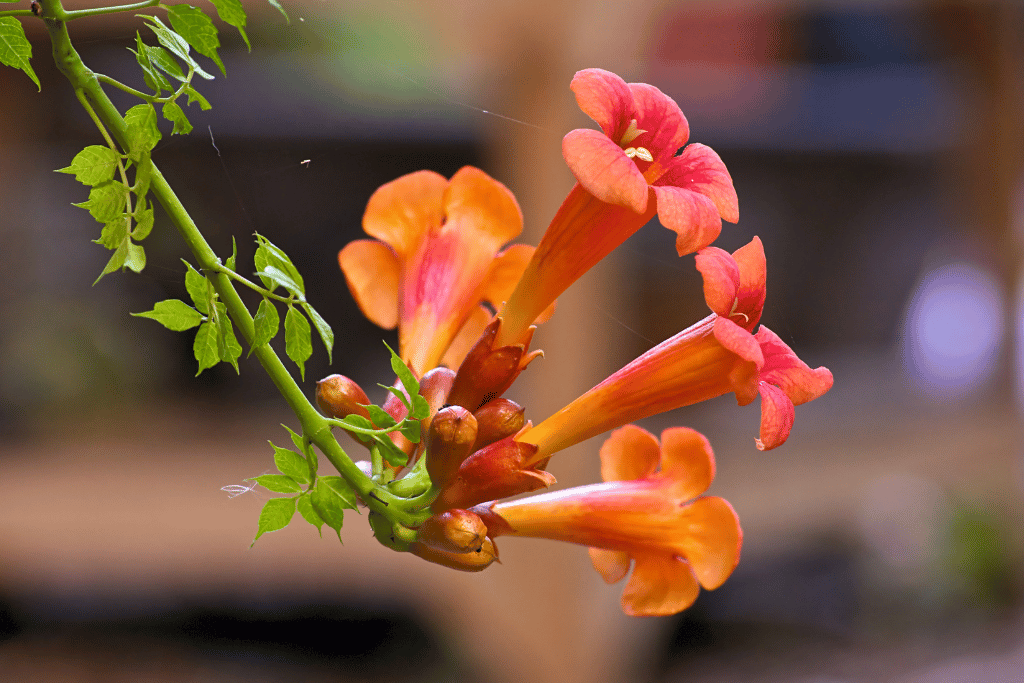
Trumpet vines remind us of the symbiotic relationships that exist in the natural world, where beauty and functionality intertwine to create a harmonious environment. These blossoms, which come in shades of red, orange, and occasionally yellow, create a lively and vibrant ambiance in any outdoor space. Native to the southeastern United States, trumpet vines are well-loved for their ability to attract hummingbirds and butterflies, adding an element of natural wonder to gardens.
Trumpet vines, scientifically known as Campsis radicans, are vigorous climbing plants that showcase an impressive display of trumpet-shaped flowers. Their rapid growth and adaptability make trumpet vines a popular choice for covering trellises, fences, and arbors. The trumpet-like flowers are designed to specifically entice pollinators, showcasing nature’s intricate mechanisms for ensuring plant reproduction.
5. Texas Bluebonnet – State Flower of Texas
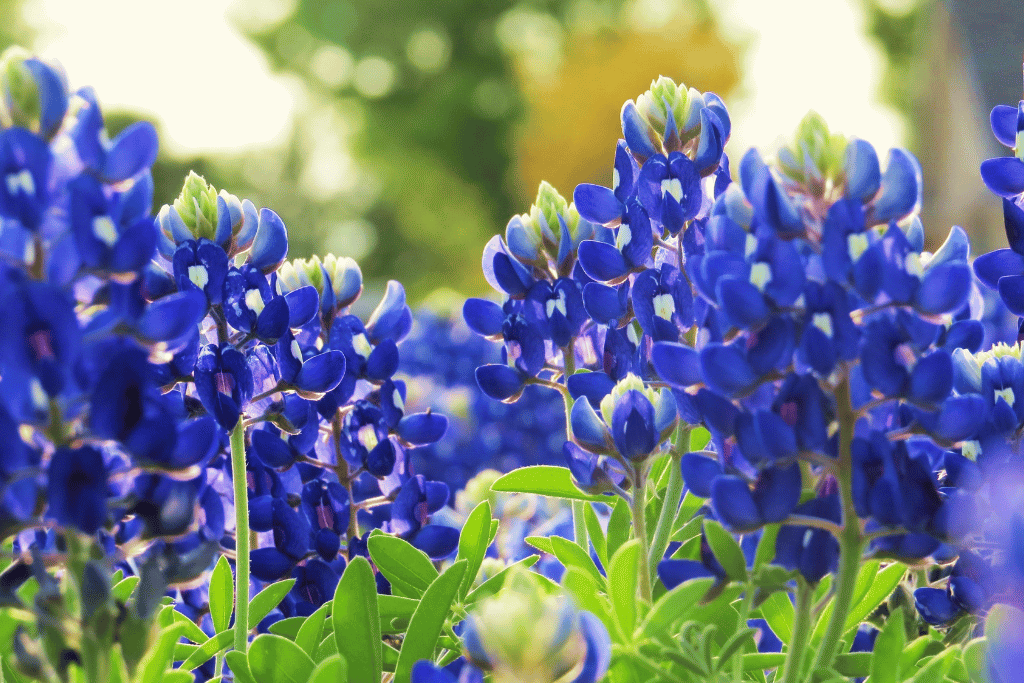
The Texas bluebonnet (Lupinus texensis) holds a special place as the state flower of Texas, covering fields with its vibrant blue-purple blossoms during spring. These wildflowers create a picturesque sight, symbolizing the state’s natural beauty and pride. Texas bluebonnets are known for their distinctive shape and characteristic white tip, which resembles a bonnet.
These hardy flowers not only beautify the landscape but also provide essential nectar for pollinators, supporting local ecosystems. The sight of vast bluebonnet fields in full bloom is a yearly spectacle that captures the essence of the Texan wilderness. Thriving in well-drained soils, Texas bluebonnets are drought-tolerant and have evolved to withstand the harsh conditions of the southwestern United States.
6. Thyme – Aromatic Herb with Small Flowers
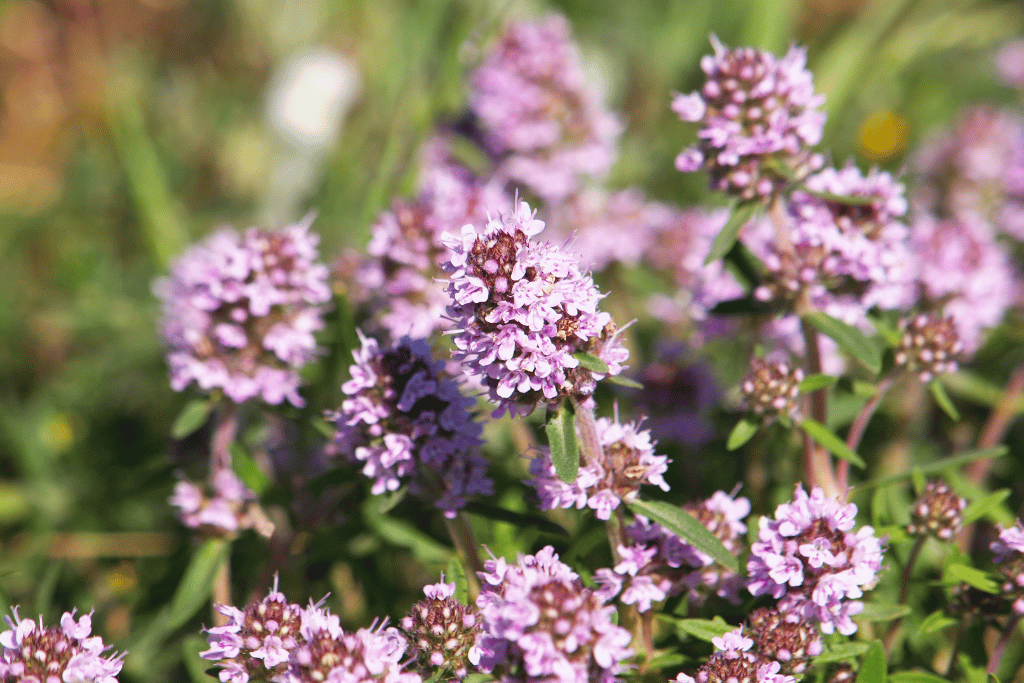
Thyme, flowers typically appear in clusters along the stems and range in color from pale purple to pink and white. Its scientific name is Thymus vulgaris, an aromatic herb used in culinary dishes and a flowering plant with delicate, small blossoms. These Thyme flowers are not only visually appealing but also attract pollinators like bees, supporting biodiversity.
Native to the Mediterranean region, thyme has a long history of culinary and medicinal use. Its flowers add a touch of elegance to herb gardens and provide a source of nectar for beneficial insects. Thyme’s aromatic leaves and flowers are often used to enhance the flavors of various dishes and teas, making it a versatile and cherished addition to both gardens and kitchens.
7. Torch Lily – Fiery and Striking Blooms
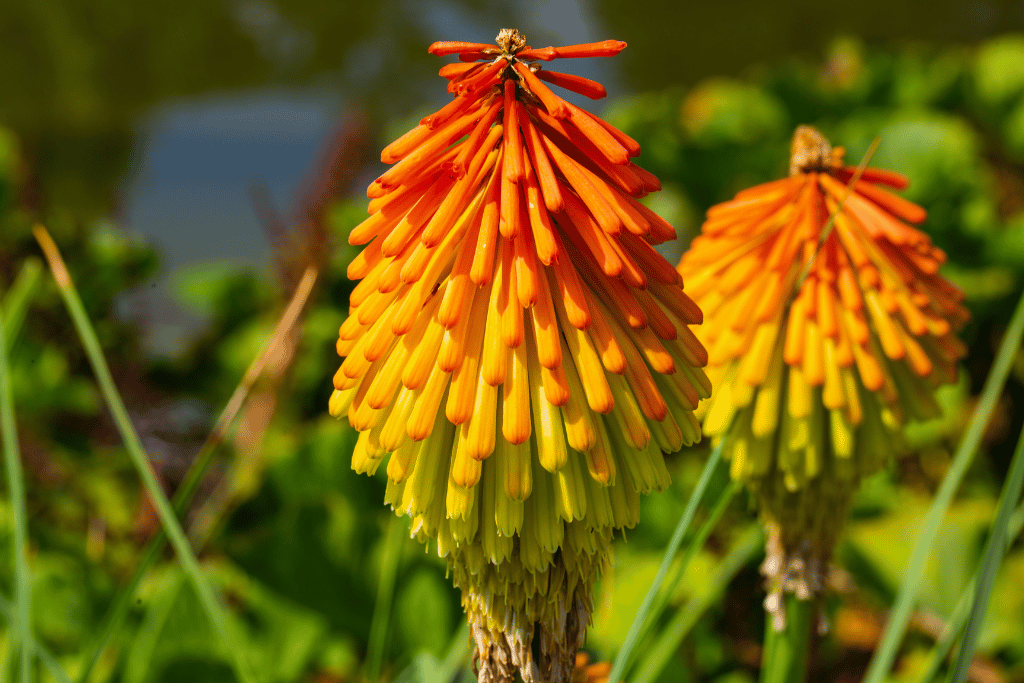
Torch lilies are loved for their ability to attract hummingbirds and other pollinators, adding vibrancy to outdoor spaces. Botanically known as Kniphofia, ignite gardens with their fiery and striking blooms. These tall plants feature clusters of vibrant flowers in shades of red, orange, and yellow, creating a visual spectacle reminiscent of torch flames.
Originating from Africa, torch lilies have adapted to various climates and soil conditions, making them versatile additions to landscapes. Their upright growth and intense coloration make them ideal focal points in garden beds and borders. As their flowers open from bottom to top, torch lilies extend their blooming period, ensuring an extended period of enjoyment for both gardeners and pollinators.
8. Toad Lily – Unique and Intricate Flowers
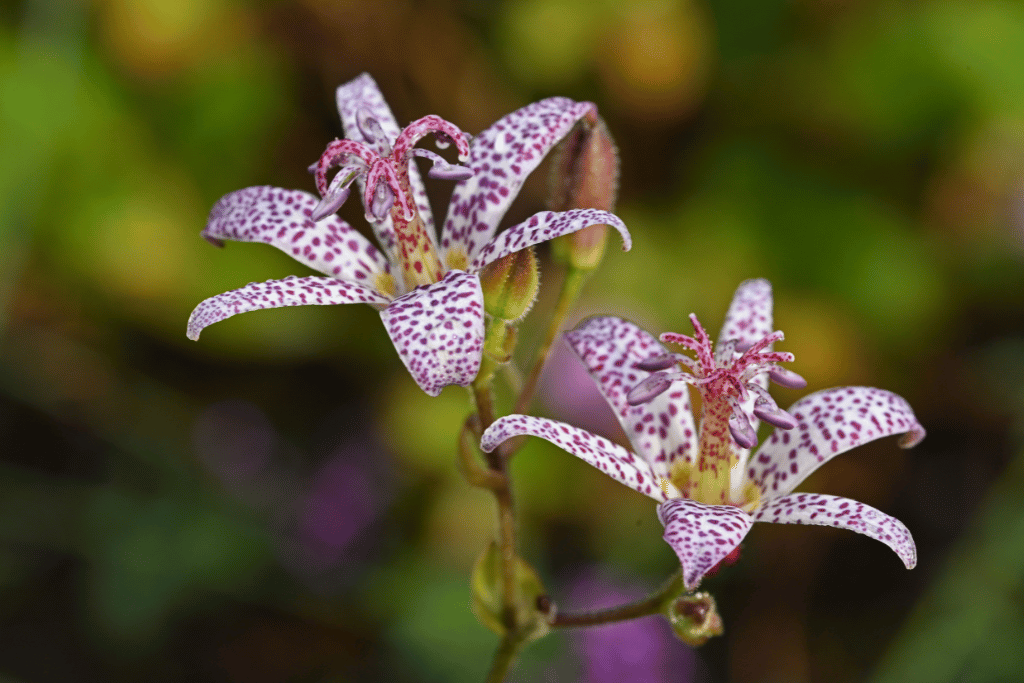
The name “toad lily” arises from the mottled appearance of the flowers, resembling the skin of toads. Their exquisite beauty and intricate details make them a delightful discovery for nature enthusiasts. Toad lilies are treasured for their ability to thrive in challenging conditions, reminding us of the resilience and delicate allure that can be found in even the most shadowed corners of our natural surroundings.
These plants, belonging to the genus Tricyrtis, offer a touch of enchantment with their unique and intricate flowers. These blooms often have speckled petals and come in shades of white, pink, and purple. Toad lilies thrive in shaded and moist environments, adding an air of mystique and elegance to woodland gardens.
9. Tree Peony – Majestic and Elegant Blooms
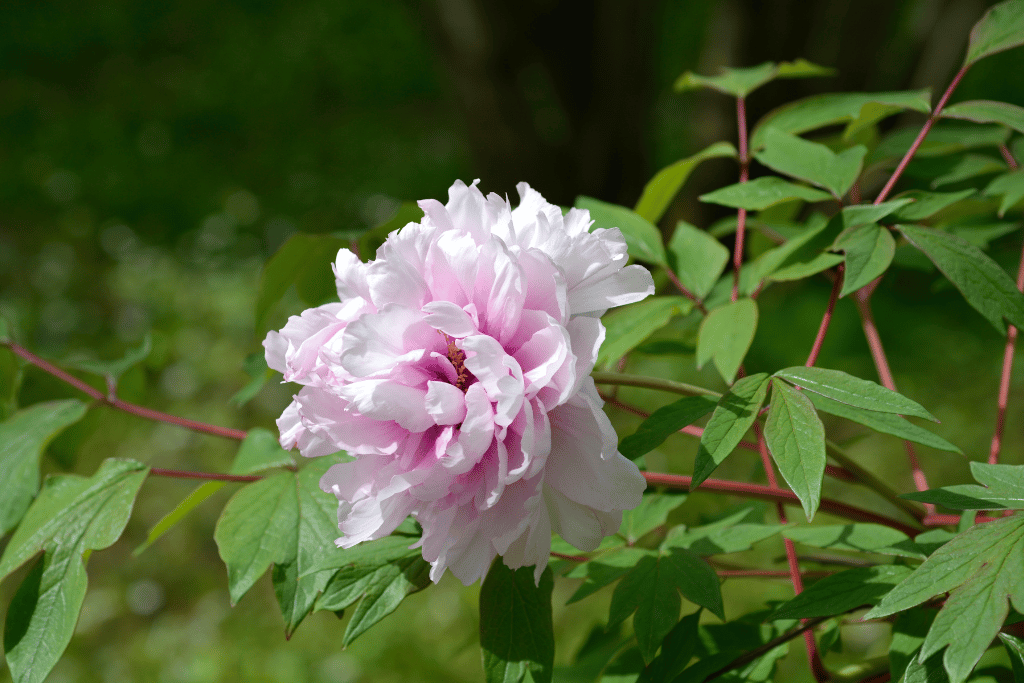
Tree peonies (Paeonia suffruticosa) stand as majestic and elegant flowering plants with large and captivating blossoms. Their regal appearance is showcased in various colors, including white, pink, and deep red. Unlike herbaceous peonies, tree peonies have woody stems and are often considered symbols of prosperity and good fortune.
Originating from East Asia, tree peonies have been cultivated for centuries for their exceptional beauty and cultural significance. Their blooms, often adorned with layers of petals, exude a sense of opulence and grace. Tree peonies are sought after by gardeners and collectors who appreciate the splendor of these enduring and enchanting flowers, making them a cherished addition to gardens that celebrate both natural aesthetics and cultural heritage.
10. Tiger Orchid – Exotic Beauty in Orchid Form
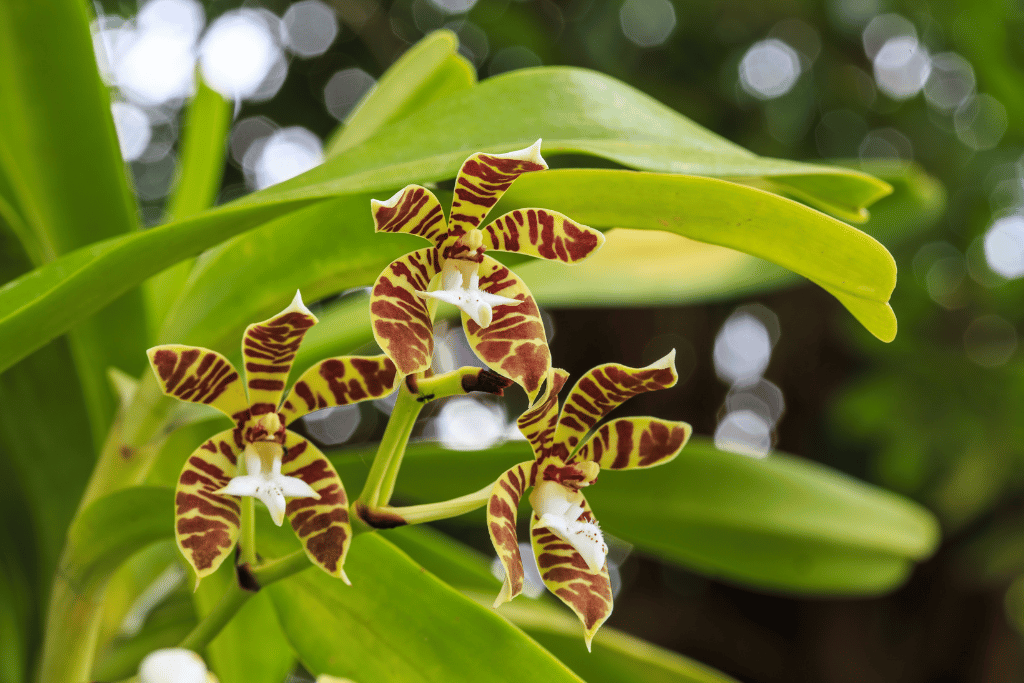
In scientific language, Tiger Orchid is named Grammatophyllum speciosum and lives up to its name with its exotic and eye-catching appearance. Native to Southeast Asia and Australia, this orchid boasts impressive pseudobulbs and large, showy flowers. The flowers often have striking markings resembling tiger stripes, further adding to their allure.
Tiger Orchids are known for their size and growth, with some specimens having pseudobulbs reaching several feet in height. These impressive plants thrive in warm and humid conditions, making them a popular choice for enthusiasts who appreciate the challenge of cultivating such a unique and impressive orchid species.
11. Tickseed – Cheerful and Bright Native Wildflower
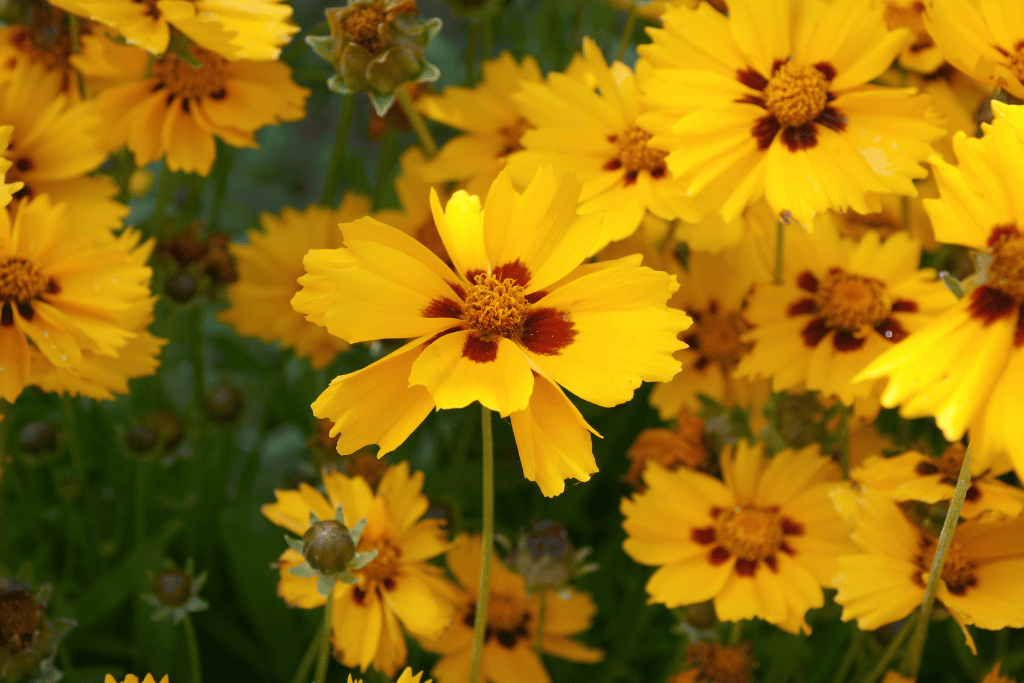
Tickseed flowers are easy to grow and attract pollinators like bees and butterflies. They symbolize happiness and joy, making them a popular choice for gardens aiming to evoke positivity and vitality. Their extended flowering period, often lasting throughout the summer, ensures a vibrant and colorful display that uplifts both landscapes and spirits.
Tickseed (Coreopsis) refers to a diverse group of flowering plants known for their cheerful and bright blooms. These native wildflowers grace gardens with their sunny yellow, orange, or red blossoms that resemble daisies. Their simple charm and resilience make them a staple in wildflower meadows and gardens alike.
12. Torch Ginger – Exotic Tropical Blossoms
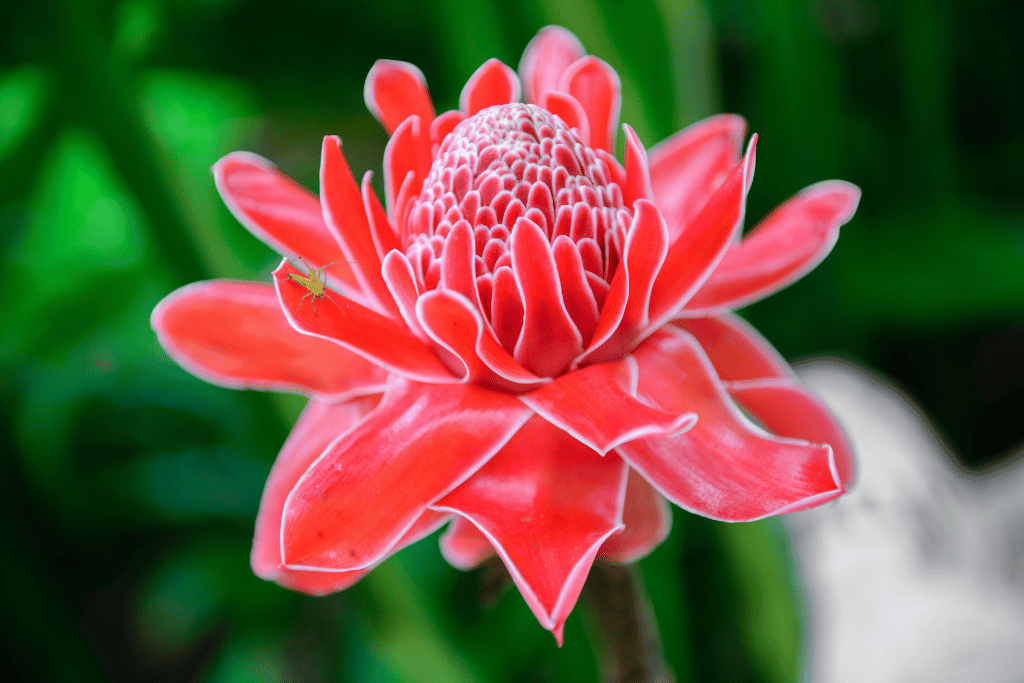
In gardens and floral arrangements, Torch Ginger provides a touch of the tropics, transporting observers to distant lands through its captivating presence. Native to Southeast Asia, its unique inflorescence consists of bracts that form a cone-like structure resembling a torch. The bracts come in various colors, including pink, red, and white, creating a striking contrast against the lush green foliage.
Torch Ginger (Etlingera elatior) is a tropical plant renowned for its exotic and stunning blossoms. Torch Ginger is not only prized for its ornamental value but also for its culinary and medicinal uses in its native regions. The flowers are often used in traditional dishes and beverages, adding flavor and fragrance.
13. Transvaal Daisy – Vibrant South African Blooms
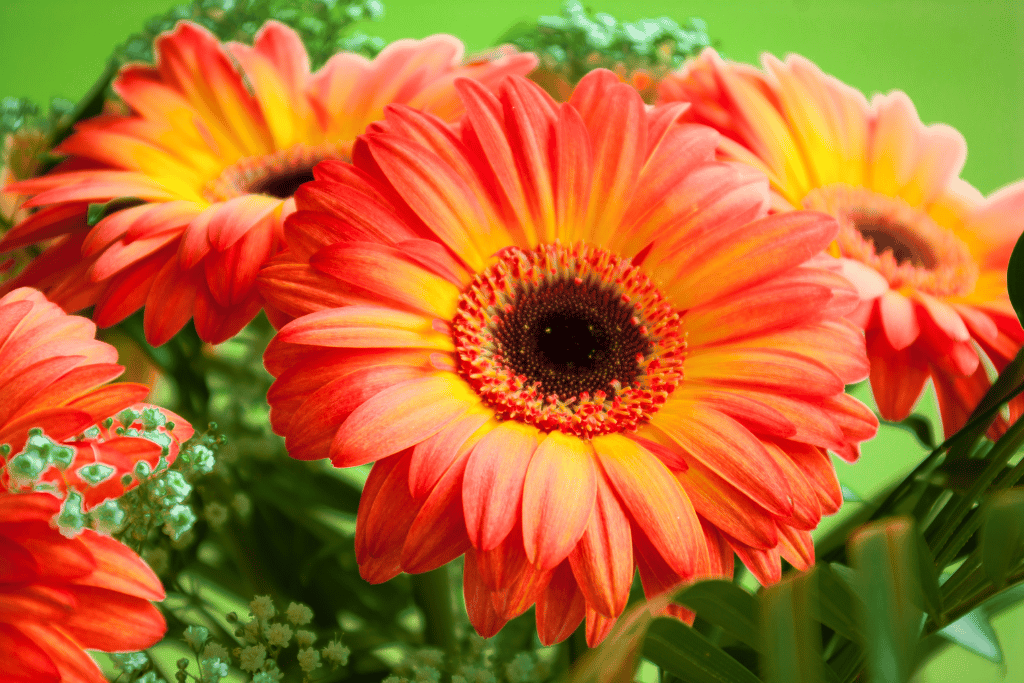
The Transvaal Daisy (Gerbera jamesonii), also known as Gerbera Daisy or Barberton Daisy, hails from South Africa and boasts a vibrant display of color. These large, daisy-like flowers come in a range of hues, including red, orange, pink, yellow, and white. Their cheerful appearance and long-lasting blooms have made them popular choices for both gardens and cut flower arrangements.
They add a burst of color to landscapes and containers, attracting pollinators like bees and butterflies. Transvaal Daisies thrive in full sun and well-drained soil. The Transvaal Daisy’s ability to brighten any setting with its bold and radiant petals showcases the beauty and diversity of flowering plants.
14. Treasure Flower – Drought-Tolerant Beauties
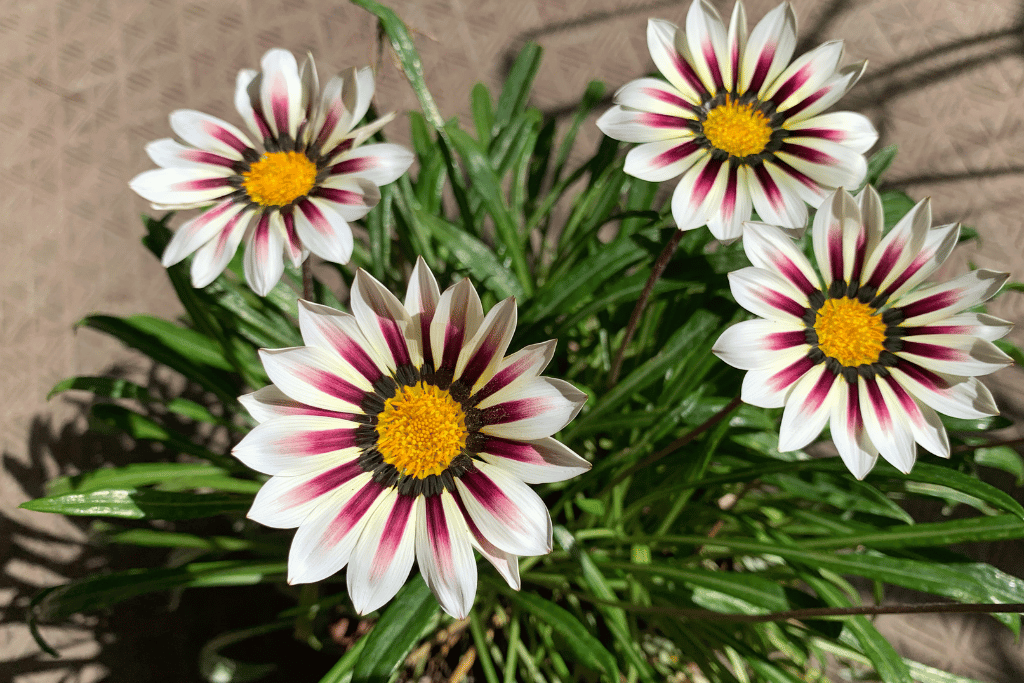
Treasure Flowers (Gazania rigens) are perfect for gardeners seeking colorful, water-wise options. The Treasure Flower’s adaptability and colorful charm remind us of the invaluable assets that nature provides even in challenging environments. Their vibrant petals close at night and on cloudy days, creating a dynamic display.
Native to South Africa, these low-growing plants produce striking, daisy-like blooms in shades of yellow, orange, and red. Treasure Flowers are often used in xeriscaping due to their ability to thrive in dry conditions. They are drought-tolerant wonders known for their resilient nature and captivating appearance.
15. Turtlehead – Graceful Wetland Blooms
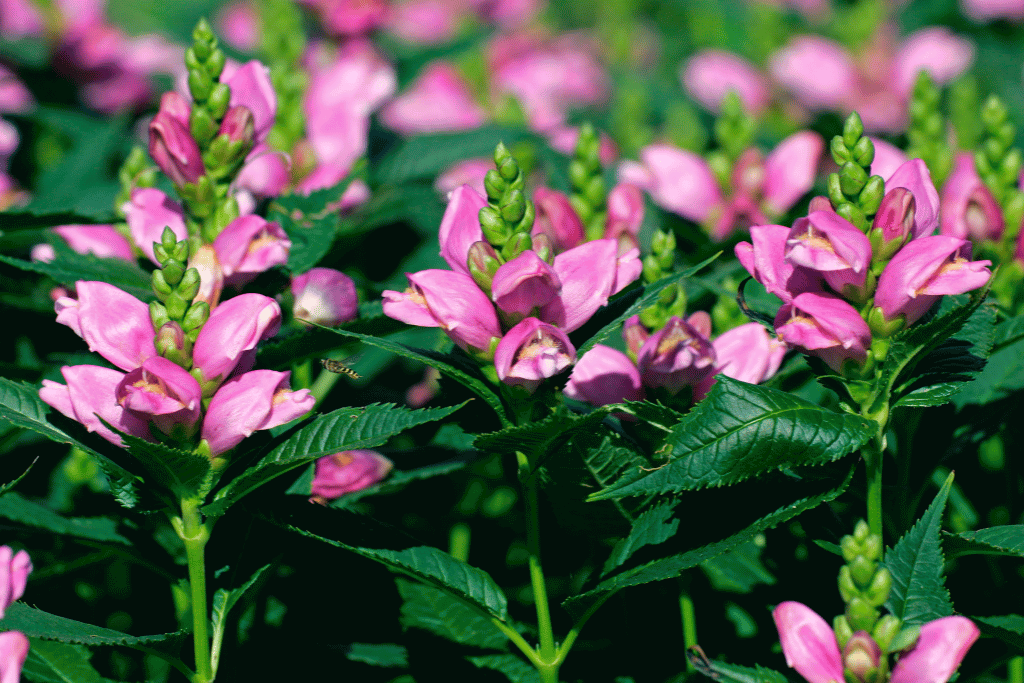
The Turtlehead (Chelone) is a graceful perennial plant known for its charming flowers that resemble the head of a turtle. Their unique form and gentle beauty bring a sense of tranquility to garden settings, reminding us of the interconnectedness between land and water. Turtlehead plants serve as a testament to the adaptability and diversity of plant life in various environmental niches.
Turtlehead flowers are attractive to pollinators like bees and butterflies, making them valuable contributors to local ecosystems. These blooms, which come in shades of pink or white, add a touch of elegance to wetland habitats and garden borders. Turtlehead plants thrive in moist soil and are often found near streams, ponds, and other water bodies.
16. Twinspur – Delicate and Colorful Cascades
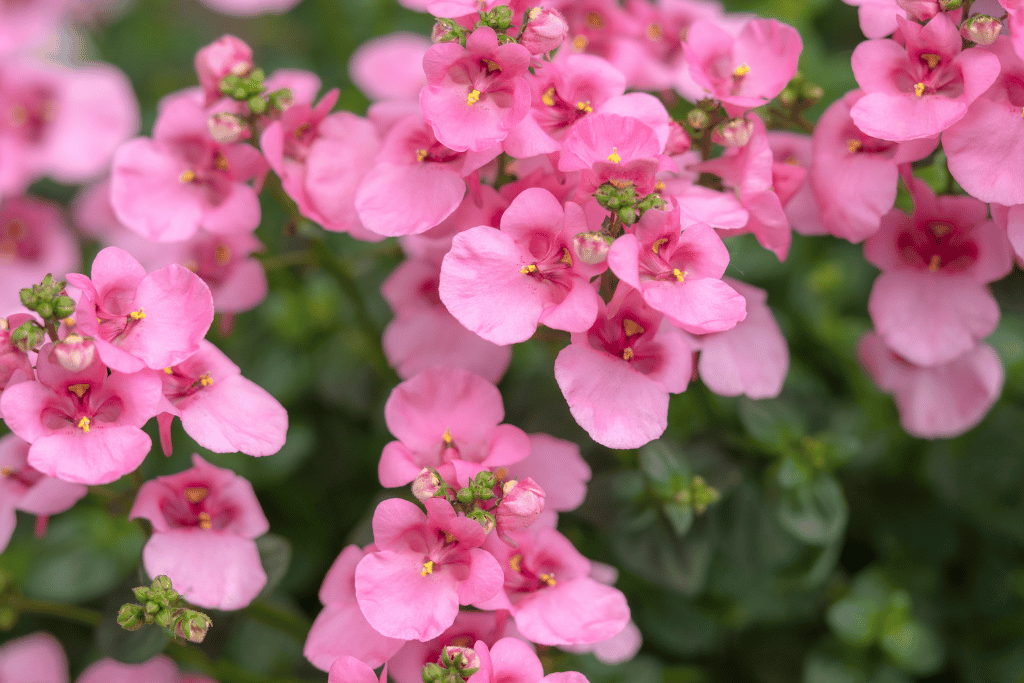
The Twinspur’s graceful appearance and profuse blooms make it a favorite choice for adding a touch of romance to outdoor spaces. Twinspur (Diascia spp.) presents delicate and colorful cascades of flowers that add charm to gardens and containers. These annual or perennial plants produce clusters of tubular blossoms in shades of pink, coral, salmon, and white.
Native to South Africa, Twinspurs thrive in well-drained soil and full to partial sunlight. They are often used in hanging baskets, window boxes, and garden beds to create a visually appealing and whimsical effect. Twinspurs’ ability to trail and drape over edges creates a sense of movement and elegance, transforming ordinary spaces into enchanting displays.
17. Tobacco Plant – Fragrant Garden Ornament
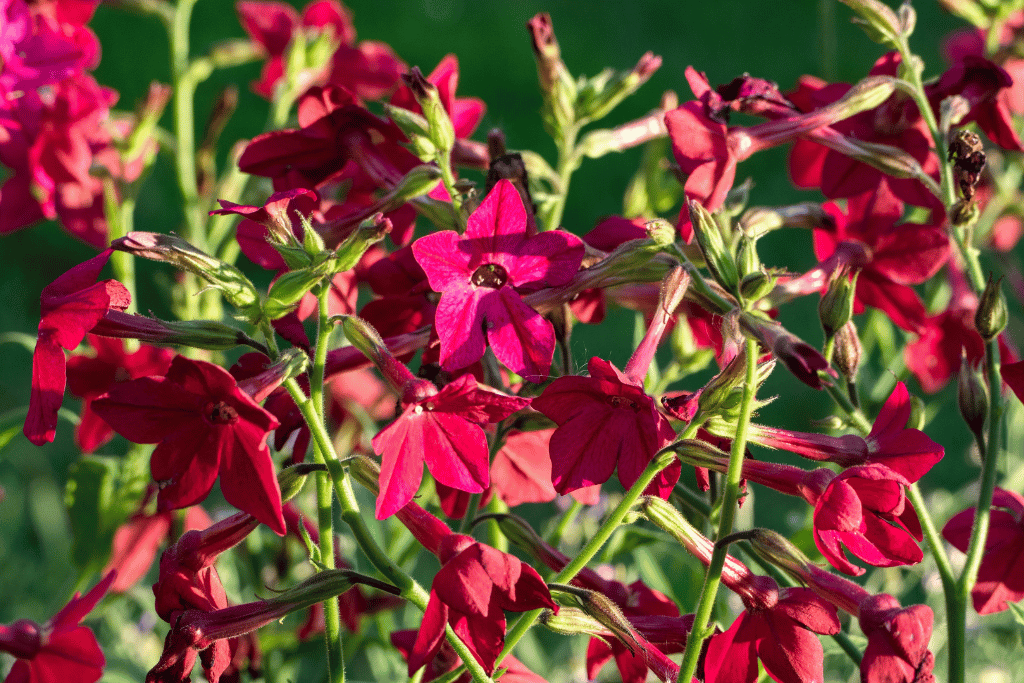
The Tobacco Plant (Nicotiana) is a fragrant and ornamental flowering plant that captivates with its evening scent and elegant appearance. Native to the Americas, these annual or perennial plants produce trumpet-shaped flowers in shades of white, pink, and vibrant hues. Their intoxicating fragrance often becomes more pronounced in the evening.
Tobacco Plants thrive in full sun and well-drained soil, making them a valuable addition to garden beds and containers. While they belong to the same family as tobacco used for smoking, ornamental varieties are cultivated for their aesthetic and aromatic qualities. The Tobacco Plant’s delicate blooms and alluring scent create an atmosphere of serenity and tranquility in gardens, particularly during the twilight hours.
18. Tartarian Aster – Autumnal Elegance in Blooms
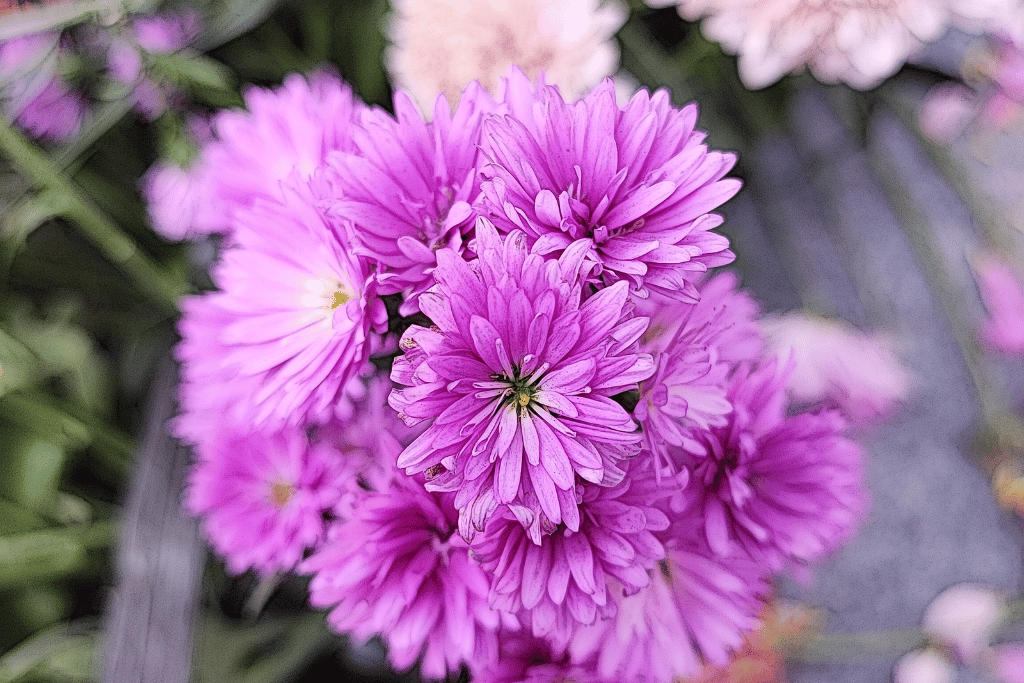
Tartarian Aster graces gardens with its autumnal elegance, offering a burst of color as summer transitions into fall. Originating from Asia, the Tartarian Aster’s flowers contrast beautifully with its deep green foliage. This perennial plant boasts masses of daisy-like flowers in shades of lavender, blue, and white. Its late-season blooms provide a valuable nectar source for pollinators, ensuring a vibrant and bustling garden.
In scientific language, these showy flowers are known as Aster tartaricus; the plant’s ability to thrive in various soil types and its late-season blooms make it a valuable asset for extending the garden’s floral display. The Tartarian Aster’s presence serves as a reminder of nature’s ever-changing and diverse palette.
19. Tennessee Coneflower – Native Beauty and Resilience
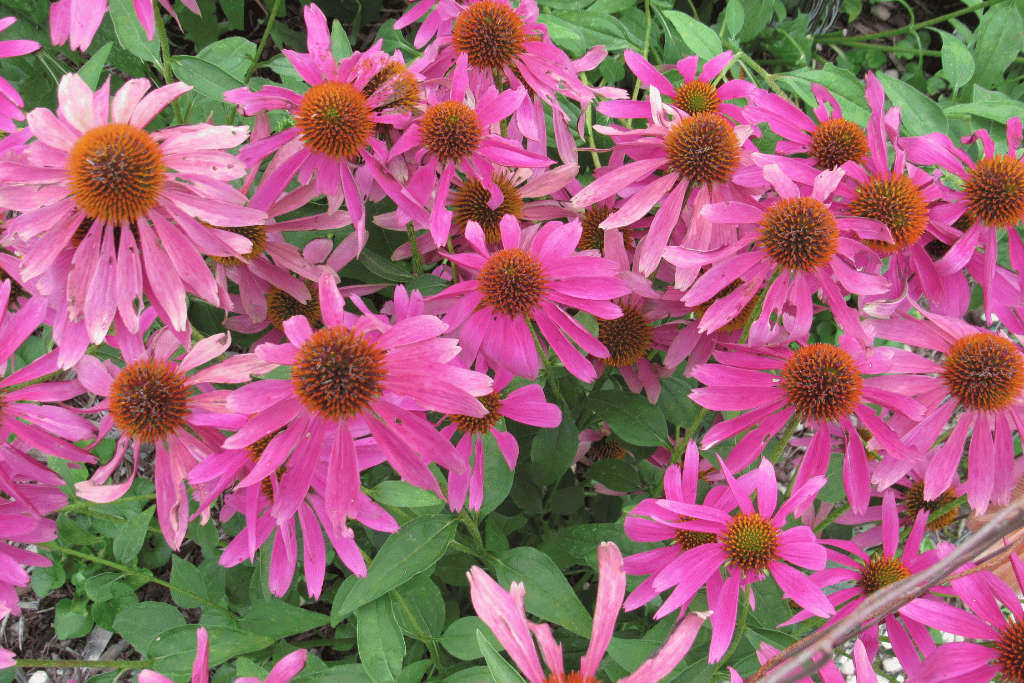
The Tennessee Coneflower (Echinacea tennesseensis) is a native wildflower that showcases both beauty and resilience. Endemic to the cedar glades of Tennessee, this coneflower features striking pink to lavender petals that radiate from a coppery-orange cone center. Its unique coloration and rarity have earned it a protected status.
Tennessee Coneflowers are well-suited for sunny, well-drained environments. They attract pollinators and contribute to local biodiversity. This wildflower’s limited range and captivating appearance serve as a testament to the delicate balance of ecosystems and the importance of conservation efforts.
20. Texas Mountain Laurel – Fragrant Southwestern Gem
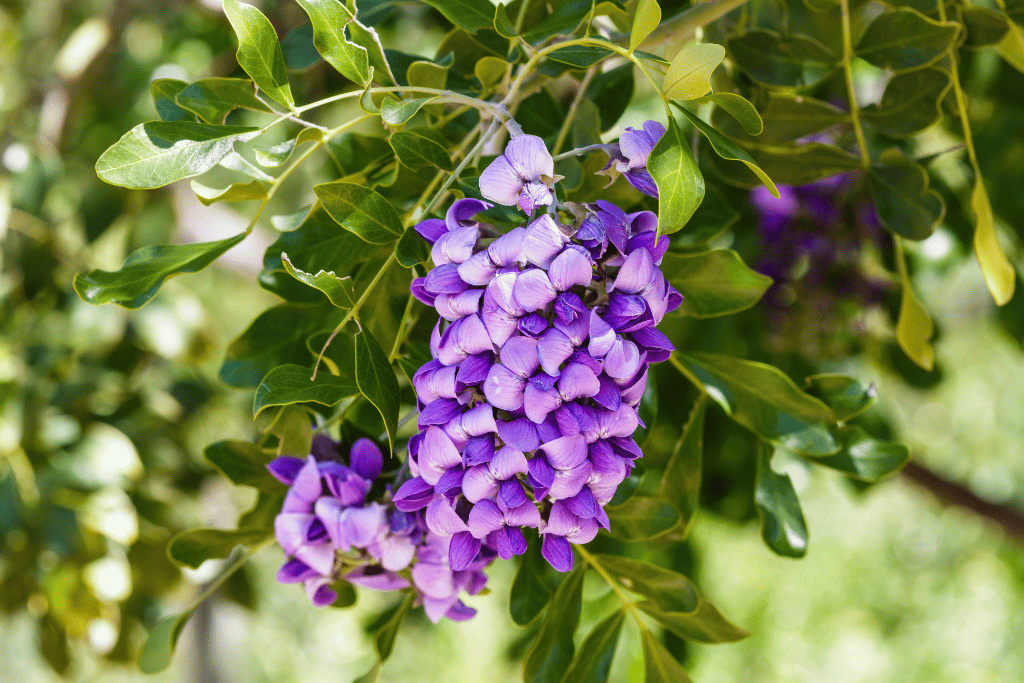
Texas Mountain Laurel is a small evergreen tree or shrub that produces clusters of violet-blue, wisteria-like flowers that exude a captivating fragrance. Its appearance and scent make it a beloved choice for gardens in arid regions.
In addition to its ornamental value, the Texas Mountain Laurel is an essential plant in its native habitats, providing food for pollinators and shelter for wildlife. The Texas Mountain Laurel (Sophora secundiflora) is a fragrant gem native to the Southwestern United States. Its adaptability to challenging conditions and stunning blooms testify to nature’s ability to thrive even in arid environments.
21. Thimbleweed – Whimsical Woodland Beauty
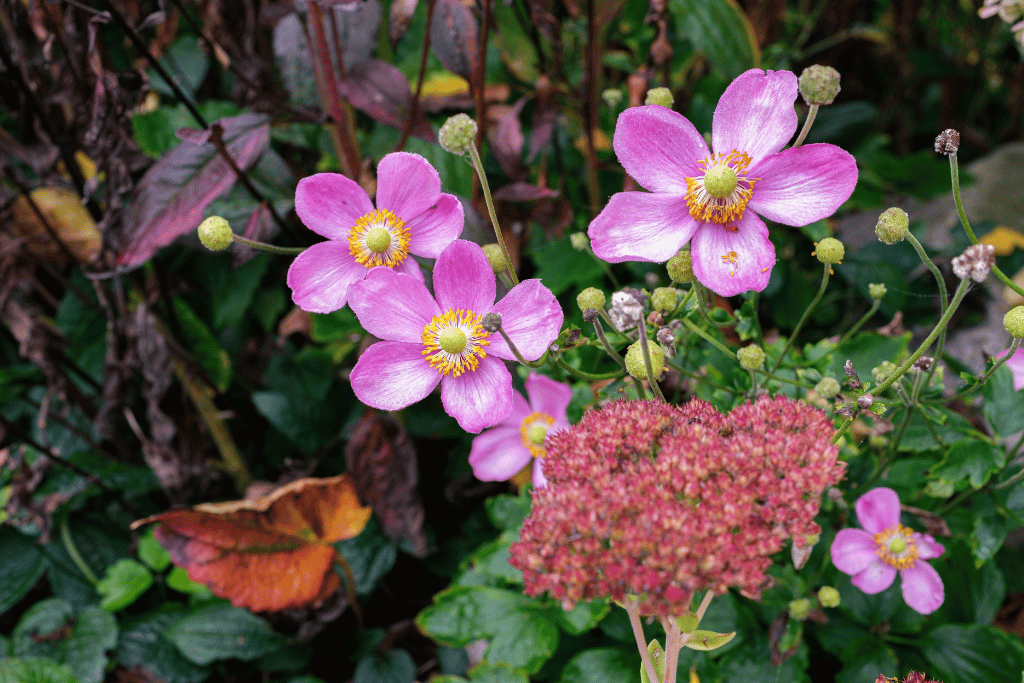
The Thimbleweed (Anemone virginiana) is a whimsical woodland flower that enchants with its delicate appearance. Native to North America, this perennial plant features white, cup-shaped flowers with a greenish center, resembling a thimble. The “fluffy” seed heads that follow the blooms add to its charm.
Thimbleweeds thrive in shaded and moist environments, often gracing the understory of woodlands. They attract pollinators and contribute to the ecosystem by providing food for wildlife. The Thimbleweed’s understated elegance and fairy-tale appearance bring a touch of magic to natural landscapes.
22. Tall Bearded Iris – Majestic and Colorful Elegance
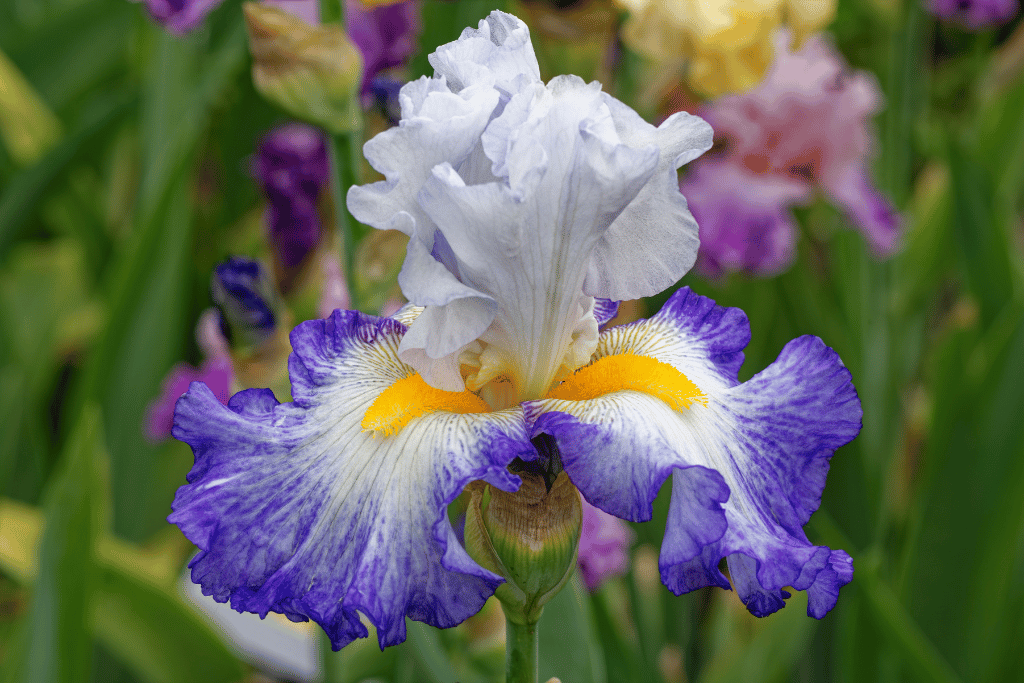
The Tall Bearded Iris (Iris germanica) is a regal and captivating flowering plant known for its majestic blooms and striking color variations. These iris flowers feature three upright petals called “standards” and three drooping petals called “falls.” Their impressive height and unique form make them focal points in landscapes, capturing the attention of passersby.
Tall Bearded Iris plants thrive in well-drained soil and full sun, adding an air of elegance to garden borders and beds. They come in an array of colors, from soft pastels to vibrant hues, often showcasing intricate patterns and markings. The Tall Bearded Iris’s ability to combine grace and vibrancy reflects the enchantment that can be found within the plant kingdom.
23. Trailing Petunia – Cascading Beauty
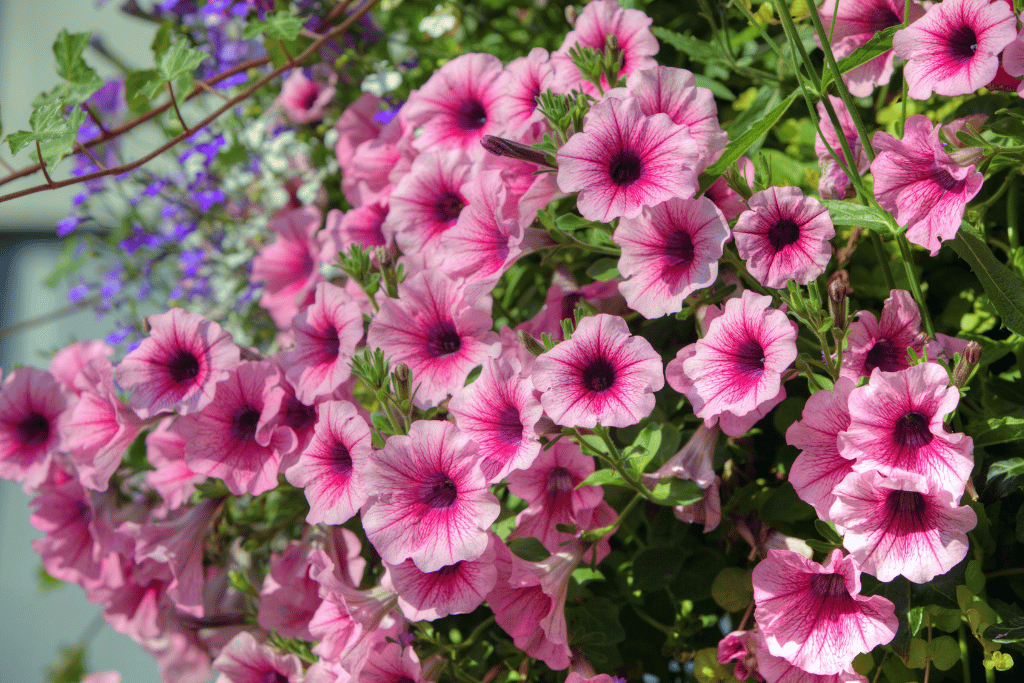
Trailing petunias are perfect for hanging baskets, containers, and window boxes. The Trailing Petunia (Calibrachoa) is a charming and versatile flowering plant that creates cascading displays of color. These compact plants produce an abundance of small, trumpet-shaped blossoms in various shades, including purple, pink, red, and white.
Native to South America, trailing petunias are well-loved for their long blooming period and ability to thrive in full sun. Their trailing growth habit adds a touch of elegance to any setting, as they spill over the edges of containers or garden structures. Trailing petunias offer a dynamic and vibrant presence, creating a visual spectacle that brightens up any outdoor space.
24. Tiger Flower – Exotic and Flamboyant Blooms
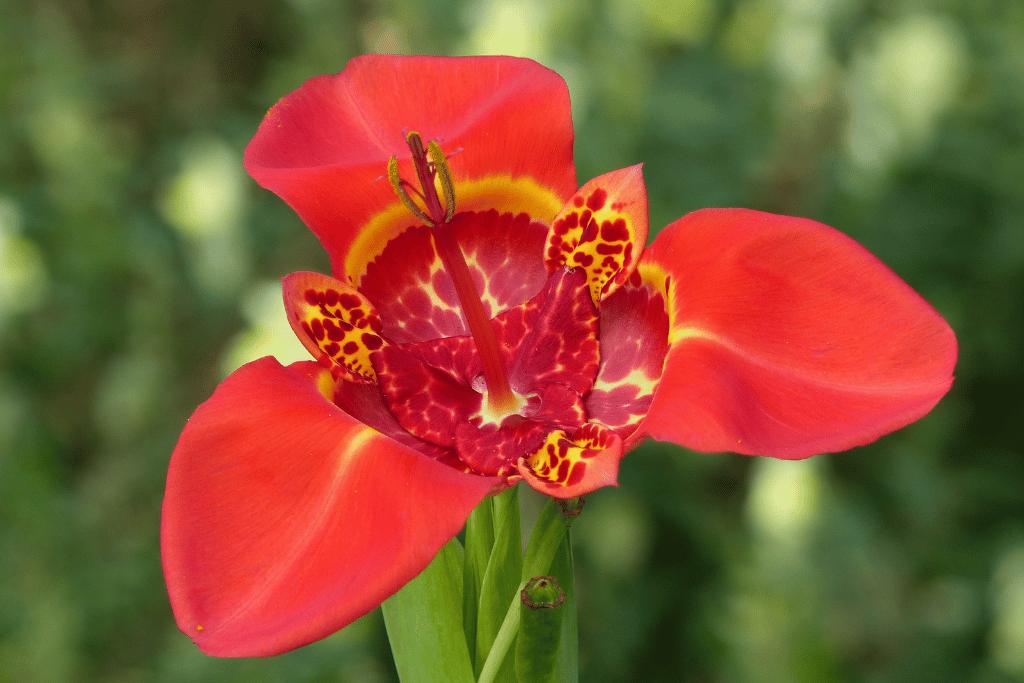
The Tiger Flower (Tigridia pavonia) showcases exotic and flamboyant blooms that steal the spotlight in gardens. Native to Central America, these flowers feature intricate patterns and vibrant colors, resembling the stripes of a tiger. Each flower lasts for only a day, but multiple blooms appear in succession throughout the blooming season.
Tiger flowers are often grown from bulbs and require well-drained soil and full sun. Their captivating appearance and brief but intense flowering period make them a cherished addition to summer gardens. The Tiger Flower’s unique and eye-catching presence serves as a reminder of the fleeting yet exquisite beauty that nature offers.
25. Twinflower – Subtle Woodland Gem
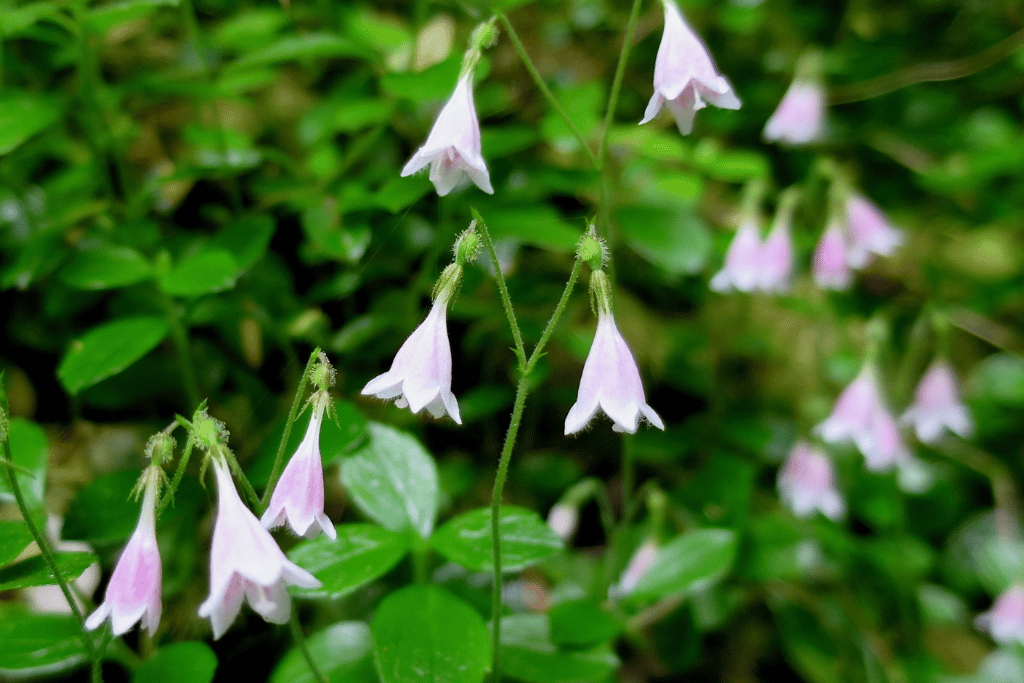
Twinflowers are often found in cool and moist woodlands, adding a touch of enchantment to natural settings. Despite their unassuming appearance, these flowers hold cultural significance in certain regions and symbolize qualities like humility and connection to nature. Twinflowers serve as a reminder that even in the quiet corners of the forest, beauty and resilience flourish.
Scientifically, Twinflower is known Linnaea borealis, a delicate woodland wildflower that graces shaded environments with its understated beauty. Native to northern regions, this perennial plant produces pairs of small, bell-shaped flowers that dangle from slender stems. The flowers are usually pale pink or white, exuding a sense of simplicity and purity.
26. Traveller’s Joy – Wild Elegance in Vines
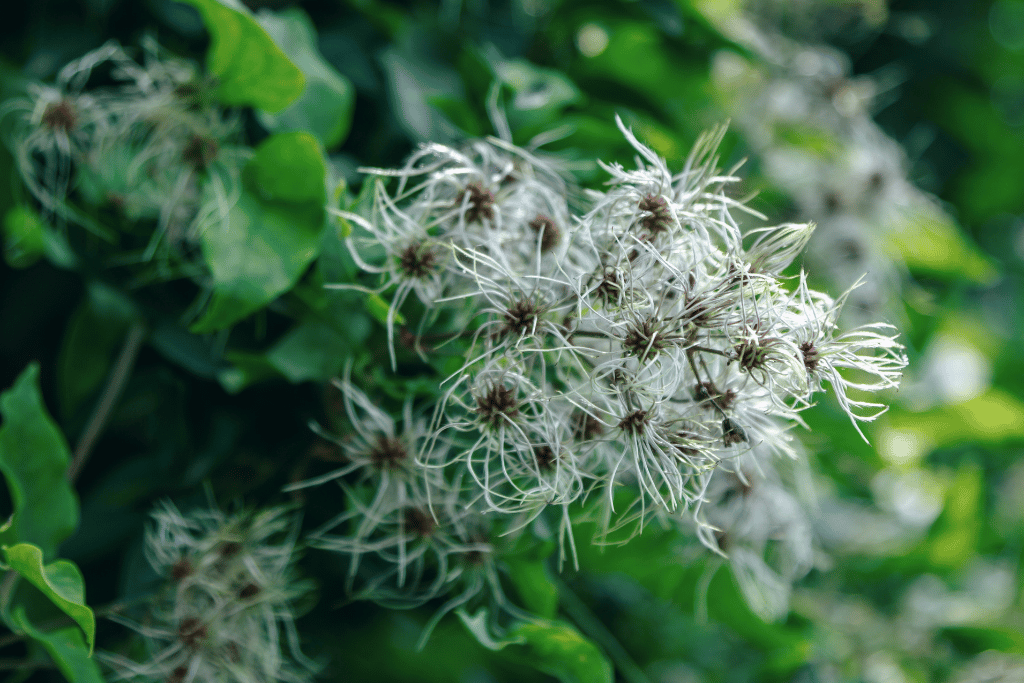
Traveller’s Joy (Clematis vitalba) is a wild and elegant flowering vine that adorns landscapes with its delicate beauty. Also known as Old Man’s Beard, this vine features clusters of small, fragrant white flowers that transform into feathery seed heads resembling fluffy beards.
Native to Europe and parts of Asia, Traveller’s Joy is a symbol of nature’s resilience and adaptability. With its climbing habit, Traveller’s Joy adds a touch of enchantment to fences, trellises, and hedges. It thrives in various soil types and can tolerate shade, making it a versatile choice for gardens. Its ethereal appearance and ability to attract pollinators make it a charming addition to naturalistic landscapes.
27. Tansy – Herbal Beauty with Yellow Blooms
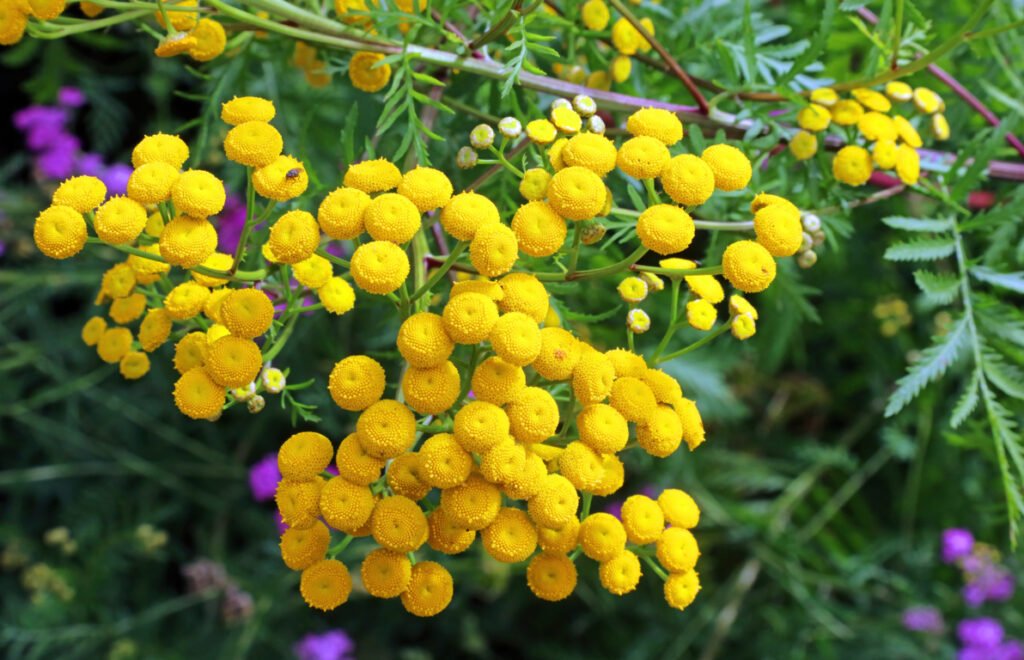
Tansy has a history of culinary and medicinal use, although its consumption should be approached with caution due to its potentially toxic compounds. In gardens, tansy acts as a natural insect repellent, deterring pests with its strong scent. Its cheerful blossoms and herbal benefits highlight the multifaceted nature of plants and their interactions with humans.
Tansy (Tanacetum vulgare) is an herbal beauty with clusters of small, yellow button-like flowers. Native to Europe, this perennial plant is known for its aromatic foliage and traditional medicinal uses. Tansy’s bright flowers attract pollinators and add a splash of color to herb gardens and landscapes.
28. Trumpet Lily – Majestic and Fragrant Blossoms
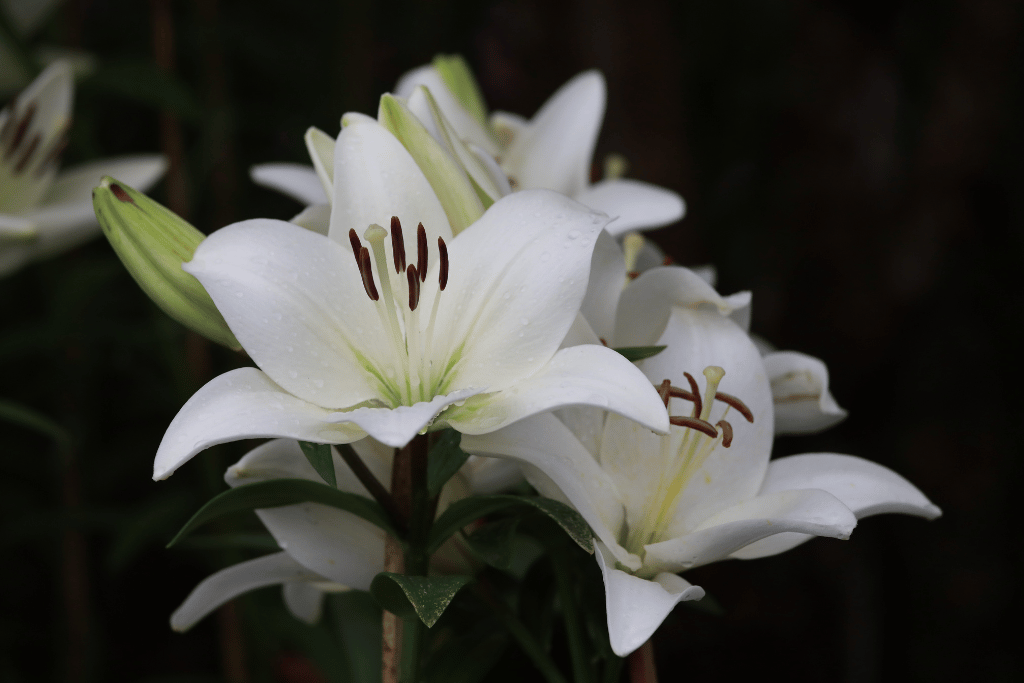
Native to Japan, this lily features pure white, elongated flowers that open wide, inviting admiration and pollinators. Trumpet Lilies are often associated with purity, making them popular choices for bridal bouquets and gardens. The grandeur of the Trumpet Lily (Lilium longiflorum) is showcased through its sizable, flared flowers resembling trumpets, accompanied by a delightful, aromatic aura.
These lilies thrive in well-drained soils and require full to partial sunlight. Their elegant appearance and sweet fragrance make them a captivating addition to both formal and informal landscapes. The Trumpet Lily’s impressive stature and timeless allure symbolize the grandeur of the natural world.
29. Turkish Cap Lily – Intricate and Whimsical Blooms
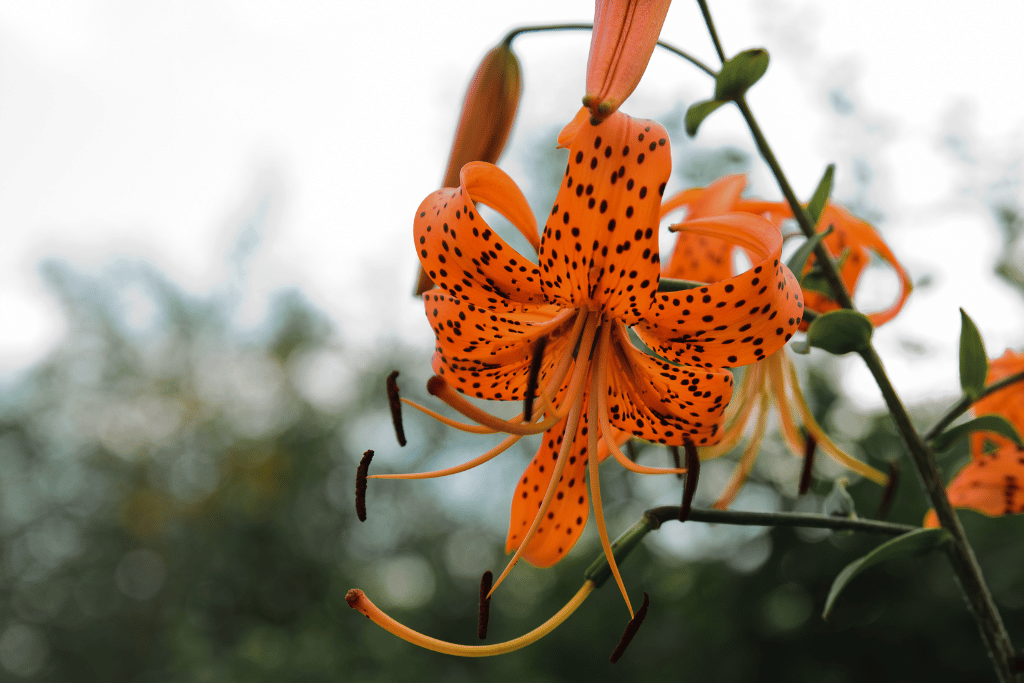
Native to Eurasia, Turkish Cap Lily produces nodding flowers with recurved petals that resemble a traditional Turkish hat. These showy flower plants, botanically known as Lilium martagon enchants with their intricate and whimsical blooms. The flowers come in shades of pink, purple, and white, adding a touch of elegance to garden settings.
Turkish Cap Lilies thrive in well-drained soils and prefer cool, shaded locations. Their unique form and intriguing patterns make them a sought-after addition for those who appreciate unusual and captivating plants. The Turkish Cap Lily’s distinctive appearance and graceful demeanor evoke a sense of old-world charm and fascination.
30. Thistle – Unique and Spiky Blooms
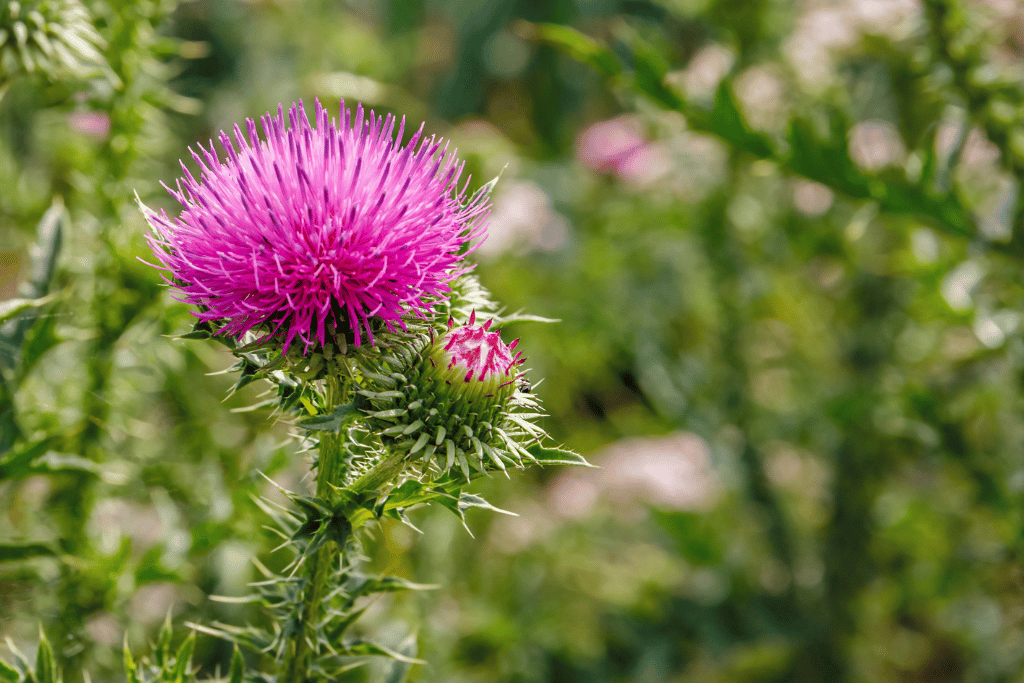
Thistles, with their spiky appearance and prickly leaves, present a unique and often misunderstood facet of the botanical world. While some consider them weeds, thistles have qualities that make them intriguing and culturally significant. The Scottish thistle, for instance, holds a special place as the national emblem of Scotland, symbolizing resilience and strength.
Thistle flowers form atop the spiky stems, offering a touch of contrasting beauty against their protective foliage. Ranging in colors from pink and purple to white, thistle blooms provide nectar for various pollinators and support local ecosystems. These flowers serve as a reminder that beauty can be found even in the most unexpected places, encouraging us to look beyond appearances and appreciate the diversity that nature offers.



